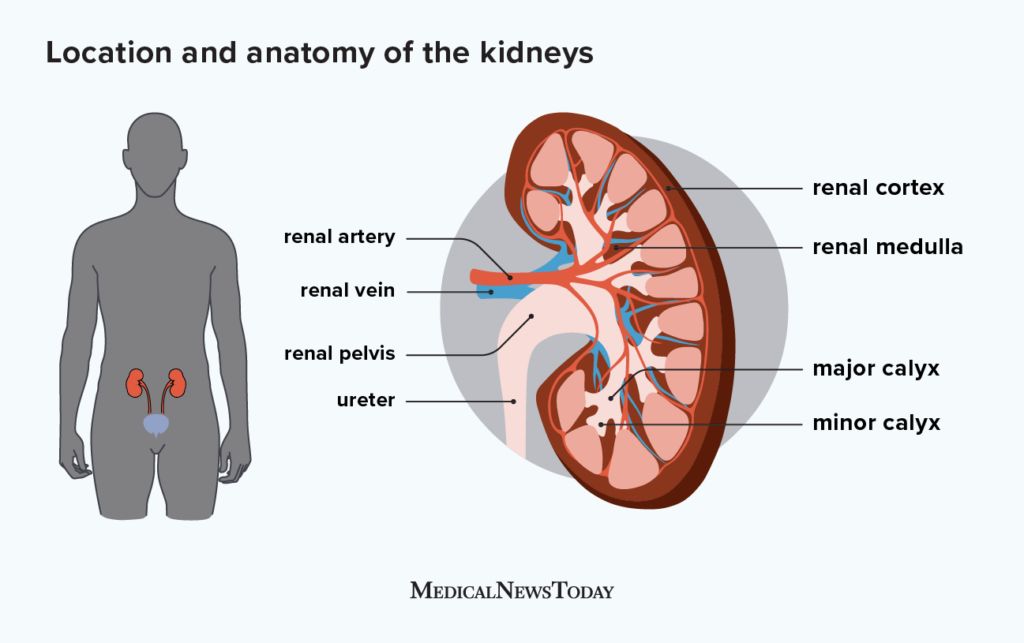The kidneys rest against the muscles of the lower back, which can make it hard to tell the difference between kidney pain and lower back pain. Additional symptoms can often help identify which type of pain it is.
When trying to determine whether the pain is coming from the back or kidneys, people need to take into account:
- the location of the pain
- the type and severity of the pain
- any accompanying symptoms
In this article, we discuss the main characteristics and causes of kidney pain and back pain. We also cover when to see a doctor.

The kidneys filter out waste and toxins from the bloodstream, which makes them susceptible to infection and damage. Excess calcium, oxalate, and phosphorous can accumulate in the kidneys to form kidney stones, which
Location
Kidney pain occurs below the rib cage on either side of a person’s spine. It can also feel as though the pain is coming from deep within the body.
People may experience pain on one or both sides of the body depending on whether a condition affects only one kidney or both kidneys.
Kidney pain can radiate to other areas of the body, such as:
- the sides
- abdomen
- groin
- thigh
Type and severity of pain
Small kidney stones often pass through the urinary system without causing much pain. However, larger stones can cause a sharp, intense pain that typically worsens when the stone moves from the kidney to the ureters. The ureters are tubes that connect the kidneys to the bladder and form part of the urinary system.
A kidney infection can cause a dull ache or soreness that remains stable.
Learn more about the anatomy of the kidneys.
Accompanying symptoms
Conditions that affect the kidneys can cause other symptoms,
- cloudy or bloody urine
- painful urination
- a persistent need to urinate
- nausea
- vomiting
- fever
- dizziness
- fatigue
Signs of severe kidney damage or problems can include:
- bad breath
- metallic taste
- shortness of breath
- swelling of the legs, ankles, or feet
- confusion
- irregular heartbeat
- muscle cramps
Conditions that cause kidney pain include:
- urinary tract infections (UTIs) including kidney and bladder infections
- kidney stones
- blood clots in the kidneys
- trauma or injury to the kidneys
Back pain is very common. According to research, an estimated
Back pain occurs as a result of problems affecting the muscles, bones, or nerves in the back.
The location, severity, and accompanying symptoms of back pain vary depending on the cause.
Location
Back pain can occur anywhere in the back. However, most people experience pain in their lower back.
Type and severity of pain
Muscle pain feels like a dull ache or soreness. Certain body movements can trigger or worsen muscle pain, the intensity of which can range from mild to severe and may fluctuate in response to stretching.
People with nerve pain may experience a burning or stabbing sensation that travels to other areas of the body.
Sciatica is a form of nerve pain that affects the back. People develop sciatica when the sciatic nerve becomes pinched or compressed, which causes a burning pain in the lower back that radiates through the buttocks.
Bone pain can result from vertebral fractures or an irregularly shaped spine. This type of pain comes on suddenly. Bone pain ranges from moderate to severe and usually worsens in response to movement.
Accompanying symptoms
Other symptoms that may accompany back pain include:
- aches or stiffness along the spine
- sharp, stabbing pain in the neck
- finding it hard to stand up straight due to pain or muscle spasms
- walking difficulties
- numbness or tingling in the back that spreads to the limbs
- weakness in one or both legs
- inability to empty the bladder
- loss of control over urination
- diarrhea or constipation
Straining a muscle or ligament in the back is a common cause of back pain. People can strain their backs from overstretching, lifting too much weight, or using incorrect lifting techniques.
Other
- poor posture
- standing or sitting for an extended period
- muscle spasms
- injuries to the back, such as fractures or falls
- damaged, dislocated, or ruptured discs
- abnormal curvature of the spine
- tumors
Medical conditions that can cause back pain include:
- inflammatory diseases, such as arthritis and spondylitis
- compression fractures from osteoporosis
- shingles
- cancer of the spine
- infections
- cauda equina syndrome, which affects the nerves at the base of the spinal cord
- abdominal aortic aneurysm
- endometriosis
A person can often treat mild back pain at home with activity modification, heat therapy, and over-the-counter pain relievers. However, people should see a doctor for pain that results from a traumatic injury.
It is important for people with symptoms of kidney stones or a kidney infection to see a doctor.
A person should also seek medical attention for any of the following symptoms:
- persistent or severe pain that does not improve after 6 weeks of conservative treatment
- back pain that gets worse over time
- pain, numbness, or tingling that radiates down the legs or into the arms
- difficulty walking or standing
- swelling of the legs, ankles, or feet
- unexplained weight loss
- sudden bladder or bowel problems
- fever
- irregular heartbeat
- shortness of breath
The kidneys sit below the rib cage on either side of the spine and rest against the muscles of the back, which means that it can sometimes be difficult to tell the difference between back pain and kidney pain.
Kidney pain can occur on one or both sides of the back just below the rib cage. Causes of kidney pain include UTIs, kidney stones, and blunt force trauma to the kidneys.
Back pain can affect the entire back, but most people experience pain in the lower back. People can develop back pain from heavy lifting, poor posture, and sitting or standing for too long. Certain medical conditions, such as arthritis, osteoporosis, and infections, can also cause back pain.
Recognizing the difference between kidney pain and back pain can lead to earlier diagnosis and a better treatment outcome.

